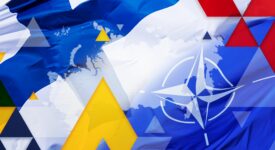Sexual violence has been used as a tactic of war across the globe for centuries. Currently, it is often seen as a phenomenon tormenting the African and Middle Eastern regions. However, widespread sexual violence was witnessed across Europe during the Second World War and has been acknowledged as a key aspect of the ethnic conflicts in the former Yugoslavia and Rwanda. To mark the 17th anniversary of the United Nations Security Council Resolution 1325 on Women, Peace and Security, we need look at how far we have come in the fight to eradicate sexual violence in conflict and at how NATO operations can be supported to enhance these efforts.
Today’s armed conflicts increasingly target civilians, exposing them to extreme violence – thousands become subject to one of the most brutal forms of hostilities: Conflict-Related Sexual Violence (CRSV). The long-term destructive nature of CRSV as well as its annihilating effect on entire communities continues to pose significant threats to global peace and security. This has led to an increased expectation that actors, including NATO military personnel, operating in conflict and post-conflict settings and mandated to protect civilians, take a more prominent role in addressing this issue.
The use of sexual violence in conflict is today recognised, codified and prosecuted as one of the most serious violations of international law. The Law of Armed Conflict (also referred to as International Humanitarian Law) and International Human Rights Law define this type of atrocity as a war crime, a crime against humanity and, in some cases, as a component of genocide. Conflict-Related Sexual Violence is often thought of as rape of women and girls during wartime. Yet, as defined in the Rome Statute of the International Criminal Court, the phenomenon is multifaceted and besides rape includes sexual slavery, forced prostitution, forced pregnancy, forced abortion, enforced sterilization, forced marriage and any other form of sexual violence of comparable gravity.
While women and girls are indeed often the primary targets of CRSV, it is also strategically perpetrated against men and boys in its frequent aim to destroy entire communities by tearing the social fabric. Moreover, reporting on extremist and terrorist groups reveals how these groups are increasingly using sexual violence tactically as part of their operational conduct. An example of this is Daesh or so-called Islamic State operating in Iraq and Syria, using CRSV as a tactic of terrorism, torture and as part of ethnic and religious targeting. Daesh, and other extremist groups such as Boko Haram, have also used CRSV as a means of attracting and retaining combatants by promising “wives” and sex slaves to its fighters. Moreover, sexual slavery has generated large revenues for these groups, which are used to finance operations through the selling of women and girls at open markets and through collecting ransom payments from traumatised communities.
To be tackled effectively, protecting civilians from Conflict-Related Sexual Violence requires a comprehensive response from military, police and civilian actors. Joint and integrated training of these actors could be a good way forward. What needs to be kept in mind is that there are many ways to protect civilians from physical violence and other threats. Military forces in operations play a crucial role in the midst of these protection mechanisms, by enhancing physical security for populations in areas affected by armed conflict. Their interaction with other relevant protection-mandated actors in the operational environment is crucial and the essential and unique role and responsibilities of the military in this mosaic of responses must be understood.
‚Combating Conflict-Related Sexual Violence‘ – Analysis by Sine Vorland Holen and Lotte Vermeij – NATO Review.







